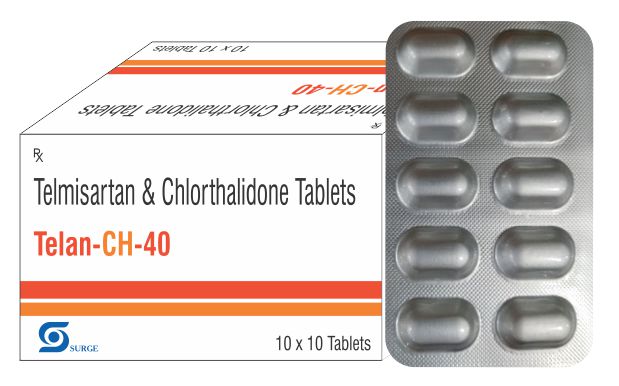Indications and Usage
● Cardiovascular Events
● Diabetic Nephropathies
● Heart Failure
● High Blood Pressure (Hypertension)
● Edema associated with congestive heart failure
Pharmacology
Mechanism of Action:
Telmisartan: Telmisartan is used to treat hypertension. Lowering high blood pressure helps prevent cardiovascular diseases and renal problems. Telmisartan is categorized as angiotensin receptor blockers (ARBs). It works by dilating blood vessels so that blood can perfuse more easily. Telmisartan blocks angiotensin II receptor that shows high affinity about 3000 times greater for AT1 than AT2. In addition it inhibits RAS, telmisartan acts as a selective modulator of peroxisome proliferator-activated receptor gamma (PPAR-γ), a central regulator of insulin and glucose metabolism. It is also believed that in diabetes and cardiovascular disease (CVD), telmisartan provide protective benefits against the vascular and renal damage caused. Telmisartan's activity at the peroxisome proliferator-activated receptor delta (PPAR-δ) receptor has prompted speculation around its potential as a sport doping agent as an alternative. Telmisartan activates PPAR-δ receptors in several tissues. Telmisartan also has a PPARγ agonist activity.
Absorption:
Telmisartan is quickly but to varying degrees absorbed from the GIT.
Absolute bioavailability depends on dosage.
Food slightly decreases the bioavailability.
Volume of distribution: 500 L
Protein binding: Highly bound to plasma protein which is over 99.5%, mainly to albumin and alpha-1-acid glycoprotein.
Binding is not dose-dependent.
Metabolism: Less than 3% of telmisartan is metabolised by glucuronidation in the liver.
Excretion:
Eliminated unchanged in feces via biliary excretion
Minute amounts were found in the urine
Half-life of approximately 24 hours.
Chlorthalidone prevents reabsorption of sodium and chloride through inhibition of the Na+/Cl- symporter in the cortical diluting segment of the ascending limb of the loop of Henle. Reduction of sodium reabsorption subsequently reduces extracellular fluid and plasma volume via an osmotic, sodium-driven diuresis. By increasing the delivery of sodium to the distal renal tubule, Chlorthalidone indirectly increases potassium excretion via the sodium-potassium exchange mechanism. The exact mechanism of chlorthalidone's anti-hypertensive effect is under debate, however, it is thought that increased diuresis results in decreased plasma and extracellular fluid volume which therefore requires decreased cardiac output and overall lowers blood pressure.
Volume of distribution: Chlorthalidone has been shown to rapidly concentrate within erythrocytes and subsequently equilibrate via a slow diffusion back into the serum compartment, resulting in a large volume of distribution.
Protein binding: Approximately 75 percent of the drug is bound to plasma proteins, 58 percent of the drug being bound to albumin. This is caused by an increased affinity of the drug to erythrocyte carbonic anhydrase.
Metabolism: Metabolised in liver.
Excretion: Approximately 50% of the administered dose is excreted unmetabolized through the kidney, and excretion is characterized by biphasic elimination with a rapid phase followed by a slow secretory phase.
Half-life of drug is approximately 40-50 hours.
Side Effects
The common side effects include:
● Sinus pain and congestion.
● Back pain.
● Diarrhea.
● Sore throat.
● Flu-like symptoms, such as fever and body aches.
● Upset stomach.
● Low levels of potassium, sodium, and magnesium in the body.
● High calcium and uric acid levels in the body.
● High blood sugar levels in those with diabetes.
Precaution & Warning
● Hypokalemia may develop with chlorthalidone as with any other diuretic, especially with brisk diuresis when severe cirrhosis is present or during concomitant use of corticosteroids or ACTH.
● Hyperuricemia may occur or frank gout may be precipitated in certain patients receiving chlorthalidone.
● Hypotension, or low blood pressure, may cause you to feel faint or dizzy. Inadequate fluid intake, excessive sweating, diarrhea, or vomiting can lead to an excessive fall in blood pressure too.
● Toxicity from telmisartan may occur with kidney dysfunction since it is filtered out of the body by the kidneys.
` Interaction
Following drugs may interact with this medication:
● Aliskiren
● Digoxin
● Lithium
● Angiotensin-converting enzyme (ACE) blockers such as benazepril, captopril, enalapril, and fosinopril.
● Angiotensin receptor II blockers such as azilsartan, losartan , olmesartan and valsartan
● Diuretics such as acetazolamide, amiloride , chlorothiazide and furosemide.
● Aspirin and other NSAIDs (nonsteroidal anti-inflammatory drugs).
Disclaimer:The data uploaded is made from content already available on internet.The company holds no right of it and is not responsible for any wrong information.
